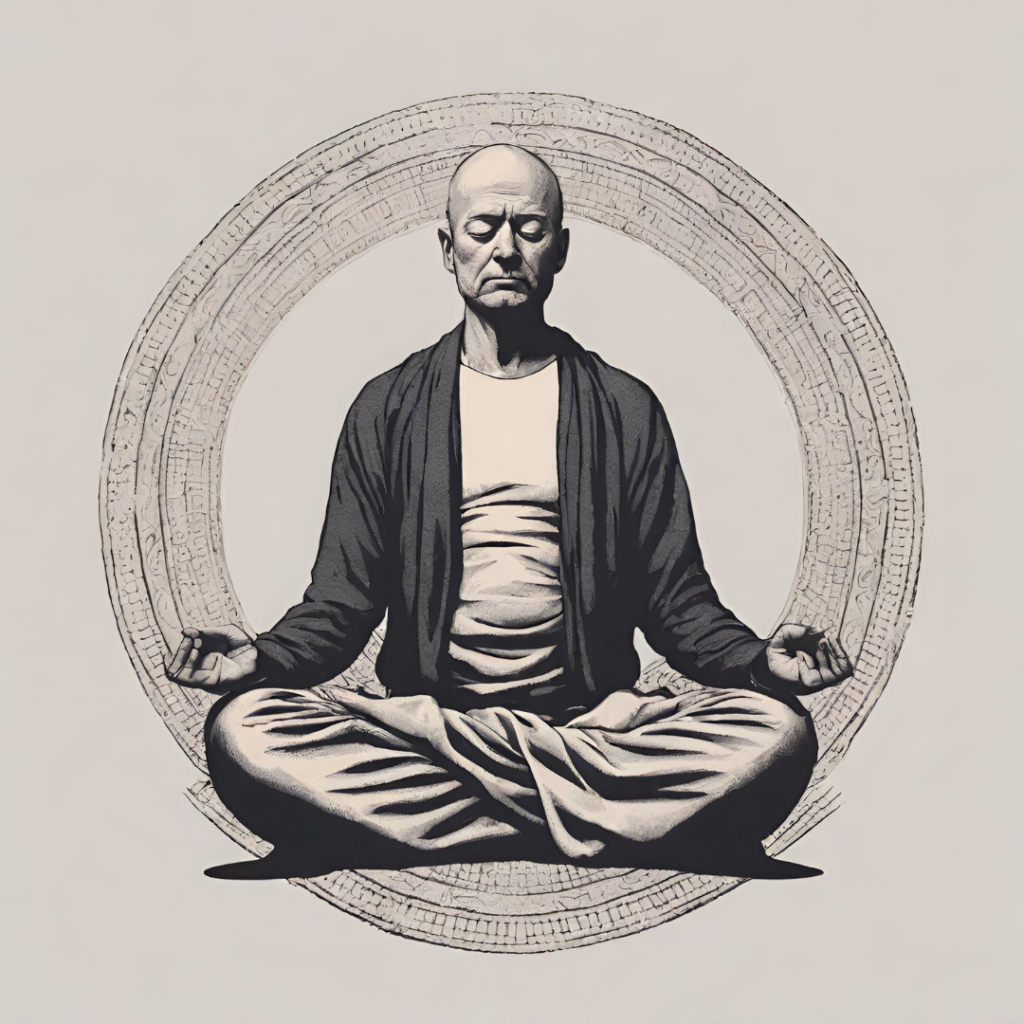During Vipassana meditation, the idea is to watch body sensations as they are, equanimously — ie. without reacting.
When I first started practicing, I was kind of unclear what “without reacting” or “equanimity” meant. Equanimity is a priced quality of a meditator and it is elusive. Sometimes I feel like I got it, and many times not. Having grappled with it for close to 100 hours across 2 months, I have made some progress. In this blog post, I want to share how I comprehend “without reacting” and “body sensations” right now, and with that I want to share what equanimity means for me. Ofcourse, my own understanding of this will keep maturing with practice. I might come back to this post in a couple of months and counter everything I have shared here.
Equanimity (or “without reacting”) does not mean, not having reactions.
Equanimity (or “without reacting”) means, watching the reactions also as they arise and pass away, just like every other sensation in the body. Reactions, like sensations, arise and pass away causally. Reactions arise, they do their thing and then soon pass away, vanish.

What does reaction mean?
Reaction is a response, evidenced by a bunch of mental-sensations, that seemingly occur along with physical sensations, in an effort to push painful sensations away and pull/retain pleasurable sensations for longer.
Said in other words, reactions disturb the perception of natural arising and passing away of physical sensations. In reality, it is not possible to hold on to physical-sensations or shun them away, because they will arise, do their thing and pass away nevertheless. Reacting with craving (pull) or aversion (push) or ignorance leaves us with an illusion of physical sensations having stuck around for longer, or disappeared sooner or leave us untouched; when in reality it takes a whole lot of mental-sensations on loop to keep that illusion in place. The capabilities of our brain to remember stuff doesn’t help this cause, as we will see shortly. Having said that, the solution is not in cutting away the faculty of memory. The solution is actually in Equanimity.
Equanimity is taking a radical-non-reaction-stance, while still paying total attention to physical-sensations that arise and pass away.
The practice (or training) in meditation is to allow reactions to happen exactly like every other physical sensation. What does “allow” mean? It means to let reactions arise and pass away, without verifying, validating, judging or otherwise do anything to pull or push them. By itself, neither the sensations nor the reactions are of any issue. Engaging with sensations or the reactions causes dukha or suffering.
How do I know my reactions?
During meditation, physical sensations become crystal clear. Breath becomes clear, heart beat becomes clear, expansion and contraction in the body becomes clear, pain becomes clear, shifting patterns of heat becomes clear, movement of gas in the body becomes clear, sound becomes clear, vibrations in the body becomes clear and so on.
Mental content also becomes clearer and clearer with practice. What would have seemed like “thinking”, now shows up as a sequence of mental-images, mental-talk and mental-sound.

For instance, previously I would have categorised “thinking about the day’s plan” as a phenomenon in itself. But now, I know that “thinking about day’s plan” is simply a series of shifting mental images, talk and sounds of imagined events that will likely happen in the day. The sequence and content of these mental images, talk and sound encapsulates within it the emotional tone, depending on how close to the mental content I find myself. By “close”, I mean how much I engage with it. The more I engage with these mental-contents, the stronger the emotional experience. Conversely, the less I engage with them, the easier it becomes to watch them arise and pass away. It also means that if I am able to watch these sensations arise and pass away, I would have developed the ability to engage with them just enough.
Having practiced breaking down “thinking” into mental images, talk and sound; I have come to see that thoughts are nothing beyond a sequence of mental sensations, each of which arise and pass away. Engaging with these mental sensations creates an emotional experience, whereas watching them arise and pass away leaves me at best amused.
It’s like when we watch a movie, the shifting images, talk and sound evoke emotions. When we watch our beloved hero being beaten up on screen, it evokes an emotional response of, say, anger. The anger doesn’t exist separately from the images, talk and sound that seems to evoke it. They all show up in one single package.

The intensity of the experienced-anger varies with the amount of engagement we have with the shifting images, talk and sound of the film. If we watch the shifting images, talk and sound from a distance, so to speak, we may still feel the emotions but we don’t get carried away by it. It is possible to watch a movie “from a mile away” and not feel anything at all. But that’s boring right? It is also possible to watch a movie “from up-close” and feel everything intensely, and sometimes even entangle ourselves with it.
Fun experiment: go back and watch a film that created an intense emotional experience for you. Watch it a couple of more times and notice how the emotional intensity reduces every time you watch it. Eventually, you are only left with nostalgia of what it felt like when you watched it the first time, but the same kind of emotions are not evoked anymore. Why? Perhaps because the drama-arc is no longer a mystery for you, and you know what will happen – therefore the shifting images, talk and sounds don’t spook you as much. Another way to think of it is: given that you know what’s going to happen next, you let the shifting images, talk and sounds be exactly that — SHIFTING. You simply let each of them arise and pass away, and don’t engage with them as much – therefore you are not entangled with them.
It’s exactly the same way with mental content. If rapidly shifting mental content (mental images, sound and talk) gets you angry or sad or anything else, you will know that you are reacting to them. Watch them again and again, the reaction goes down and down and down; until they simply become shifting frames of mental content.
Coming back to the question of: “how do I know I am reacting?“
As you meditate and observe physical sensations. Notice how every once in a while, you are pulled away by mental sensations (image, talk and sound) showing you a movie with content from your life.
- If the mental-content conveys aversion, you are reacting with aversion.
- If the mental-content conveys craving, you are reacting with craving.
- If the mental-content conveys an escape to fantasy land, you are reacting with ignorance.
It is as if mind is representing reaction using mental-content as a tool.
The reaction doesn’t exist separately from the mental-content, it is in fact the mental-content itself. Watch the mental-content, dissolve it into image, talk and sound and notice how quickly the mental-content disappears as does the reaction; and almost immediately you are back with your physical body-sensations.
Soon, you will be able to observe a pattern:
- “painful-body-sensations” -> “aversion mental content”,
- “pleasurable-body-sensations” -> “craving mental content”, and
- “boring-body-sensations” -> “fantasy land mental content.”
In any case, all mental content is simply shifting frames of mental-sensations (image, talk and sound). They all arise and pass away, even if it logically seems like the images, talk and sound are either pulled in from or put-together from memory. The faculty of memory happens to aid the fomenting of mental-content, but that’s just circumstantial. It is the reaction that we have to watch out for. If there is no reaction, no mental-content gets fomented, even though memory as a faculty still exists.
What is Equanimity?
Equanimity is simply a matter of letting the shifting frames of mental content and the constantly changing physical sensations be exactly that — SHIFTING. We simply let them arise and pass away.
While we are practicing equanimity intensely in sitting meditation, we can observe our habitual reactions by observing the mental-content that show up.
As said before, the shifting-frames-of-mental content are the reactions. Said in other words, the shifting-frames-of-mental content are a representation of our reaction to body sensations.
- If the mental-content portray aversion, then we are reacting with aversion to the current body sensation.
- If they portray craving, then we are reacting with craving to the current body sensation.
- If they portray some “escape to fantasy land”, then we are reacting with ignorance to the current body sensation.
It’s as if the mind is fomenting mental-content in an effort to explain or comprehend current physical/body sensations.
As we stay equanimous to all sensations (both physical and mental), slowly we will begin to notice that for certain body sensations, mental-content is no longer fomented.
For example, previously along with sensation of pain-in-the-leg, mental-content of fight-with-my-wife or getting-a-flat-tyre-on-the-highway or something else “painful” would show up. It’s as if my mind was explaining what pain-in-the-leg means in terms of mental-content. As I dissolved mental-content by breaking them apart in terms of image, sound and talk; I began to notice that pain-in-the-leg would simply show up as pain-in-the-leg. After a while, I was able watch that physical pain and dissolve it into its fundamental elements of vibration, until the pain disappeared entirely.
By engaging with mental content that my mind fomented in an effort to explain or comprehend the physical pain, I would be consciously throwing ghee into the fire and let it rage even more. On the other hand, by watching each component of it distinctly and letting them arise and pass away, they all seem to “run out of gas” and disappear entirely.
Radical non-reaction allows us to acknowledge sensations, while not getting entangled in them.
Increasingly, I am now able to watch a lot of physical sensations as-is, without feeling the need to engage with the mental-content that my mind foments in an effort to explain or comprehend the physical/body sensations.
- While driving, the visual physical sensation of “someone cutting me off on the road” was hitherto also represented as a rapidly-shifting-mental-frames of all the past and imagined times when I was wronged or cheated. The mental-frames would be vivid with images, talk and sound. However, it now shows up as “someone cutting me off on the road”, as simply a visual sensation that arises and passes away.
- The auditory physical sensation of “vessels banging on the kitchen cabinet” was hitherto also represented as a rapidly-shifting-mental-frames of all the past when my mother would bang vessels in the kitchen, only to beat me up or scold me or humiliate me shortly later. It now shows up as “vessels banging on the kitchen cabinet”, as a sound sensation that arises and passes away.
To watch physical sensations “without reacting” means to let physical sensations show up only as physical sensations and not have them be represented by mental-content.
It is very much true that there is still a huge pile of physical sensations that continue to get represented by mental-content automagically, and I am not present enough to watch them arise and pass. Surely, I am watching those mental-movies a bit-too closely, so much so that I engage and get entangled with them. But I know that the “huge pile” though huge, it is also finite. It’s just a matter of consistent practice and time before I watch them over and over again, until I am able to watch them like an old movie without getting entangled. Soon, my mind will give up representing physical sensations with mental-content, and physical sensations will be exactly what they are: transient.
To me, being equanimous is all about being able to objectively watch reactions to body-sensations being represented by mental-content (images, talk & sound) over and over again until body-sensations simply occur as body-sensations with no mental-content to go along with it.
If I stay with sensations as-is, without needing mental-content to represent it, then I can dissolve each phenomenon into its fundamental elements and watch them all arise and pass away.
In addition to formally practicing this during my sitting-meditation sessions, I also practice this while working out at the gym. In the past few weeks, I noticed how the last few reps in each set would foment a whole lot of frustrating mental-content.

At first, I simply brought myself to awareness that the frustrating mental-content is likely to show up during the last few reps of each set, and that it was simply the mind’s way of trying to make sense of the pain that occurs during workouts.
Slowly, I was able to watch “pain during workouts” as “pain during workouts”.
Now, I am beginning to develop the ability to watch the pain-sensations closely, with no mental content bothering me.
What will happen next, I don’t know. But I sure am enjoying my workouts better. In a way, workouts have become meditation sessions too.
